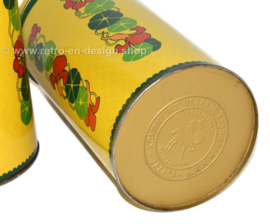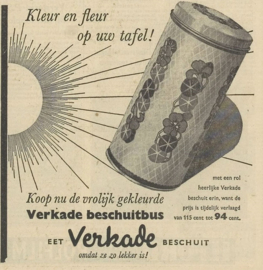A R C H I V E
Set of two cylindrical yellow vintage Verkade biscuit tins with nasturtiums
SKU: BT-3073-20Set of two cylindrical yellow vintage Verkade biscuit tins with nasturtiums.
- Manufacturer: Fa. Verkade
- Design: Cees Dekker
- Dates: 1960 - 1980
Rusk tins from the Koninklijke Verkade Fabrieken Zaandam.
Description
Two straight round tins of rusk tins with a slightly convex loose lid. The decoration of this bus consists of a yellow background with a lighter yellow diamond pattern and with a green bottom edge. The bush is regularly divided in length with 6 clusters of flower tendrils and nasturtium leaves in green, red and yellow. Also a wreath of the same tendrils on the lid. The lid also has a rolled edge and the tin has a seamed longitudinal seam on the back.
The brand logo is pressed into a circle in the bottom: ROYAL VERKADE FABRIEKEN N.V. ZAANDAM, registered factory mark.
Condition
This set of biscuit tins is in a neat vintage condition with normal traces of use and age-related traces of wear. Photos are part of the description.
Size
- Height: 21 cm.
- Diameter: 10 cm.
Verkade.
Verkade was founded on 2 May 1886. Then Ericus Gerhardus Verkade opened his steam, bread and rusk factory "De Ruyter" (The Rider). The name "De Ruyter" was chosen with a bow to the past; the first flour mill of West Zaandam bore that name. The products of the first hour were; bread, rusks, honey gingerbread and Langetjes (kind of biscuits), "De Ruyter" is still recognizable in the logo of the Verkade brand.
Tropaeolum majus (garden nasturtium, Indian cress, or monks cress) is a species of flowering plant in the family Tropaeolaceae, originating in the Andes from Bolivia north to Colombia. An easily-grown annual with disc-shaped leaves and brilliant orange or red flowers, it is of cultivated, probably hybrid origin. It is not closely related to the genus Nasturtium (which includes watercress).
It is a fast-growing plant, with trailing stems growing to 3–6 ft (0.91–1.83 m). The leaves are large, nearly circular, 3 to 15 centimetres (1.2 to 5.9 in) in diameter, green to glaucous green above, paler below; they are peltate, with the 5–30 cm long petiole near the middle of the leaf, with several veins radiating to the smoothly rounded or slightly lobed margin. The flowers are 2.5–6 cm diameter, with five petals, eight stamens, and a 2.5–3 cm long nectar spur at the rear; they vary from yellow to orange to red, frilled and often darker at the base of the petals. The fruit is 2 cm broad, three-segmented, each segment with a single large seed 1–1.5 cm long.
All its parts are edible. The flower has most often been consumed, making for an especially ornamental salad ingredient; it has a slightly peppery taste reminiscent of watercress, and is also used in stir-fry. The flowers contain about 130 mg vitamin C per 100 grams (3.5 oz), about the same amount as is contained in parsley. Moreover, they contain up to 45 mg of lutein per 100 gr, which is the highest amount found in any edible plant. The unripe seed pods can be harvested and dropped into spiced vinegar to produce a condiment and garnish, sometimes used in place of capers.
Some translations come from an automated system and may contain errors.
Country of origin
The Netherlands - Holland
Kind of object
Biscuit tins by Verkade
Theme
Rusk tins - biscuit tins - product packaging - holder
Decoration
Nasturtium
Category
Vintage tins
Color
Yellow - orange - green - red
Publisher
Verkade's fabrieken Zaandam
Manufacturer
Verkade Fabrieken Zaandam
Designer
Cees Dekker
Brand
Verkade
Material
Tin - metal - paint
Particularities
Loose lids - Set of two
Era
1960 - 1980
Quality
Good vintage condition
Height
21,00 cm
Diameter
10,00 cm
Shipping method
Parcel post with track & trace























